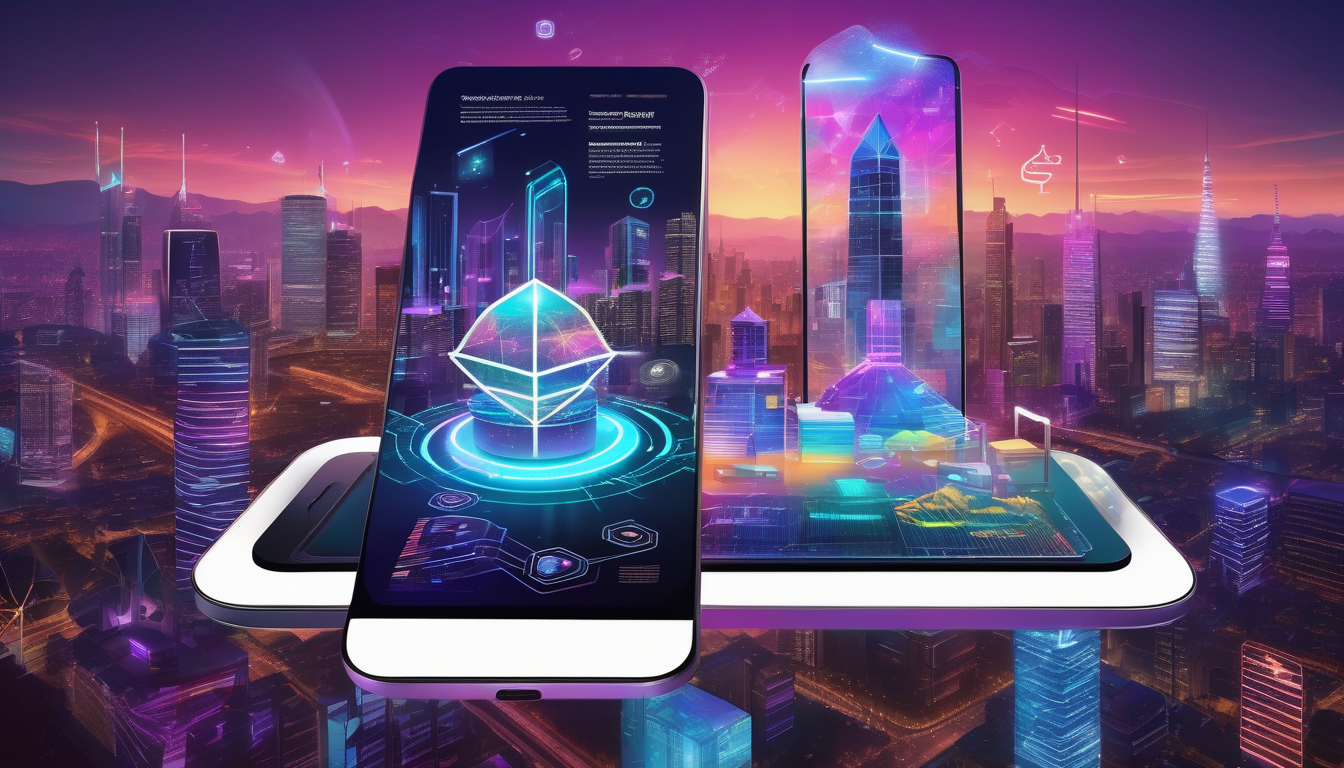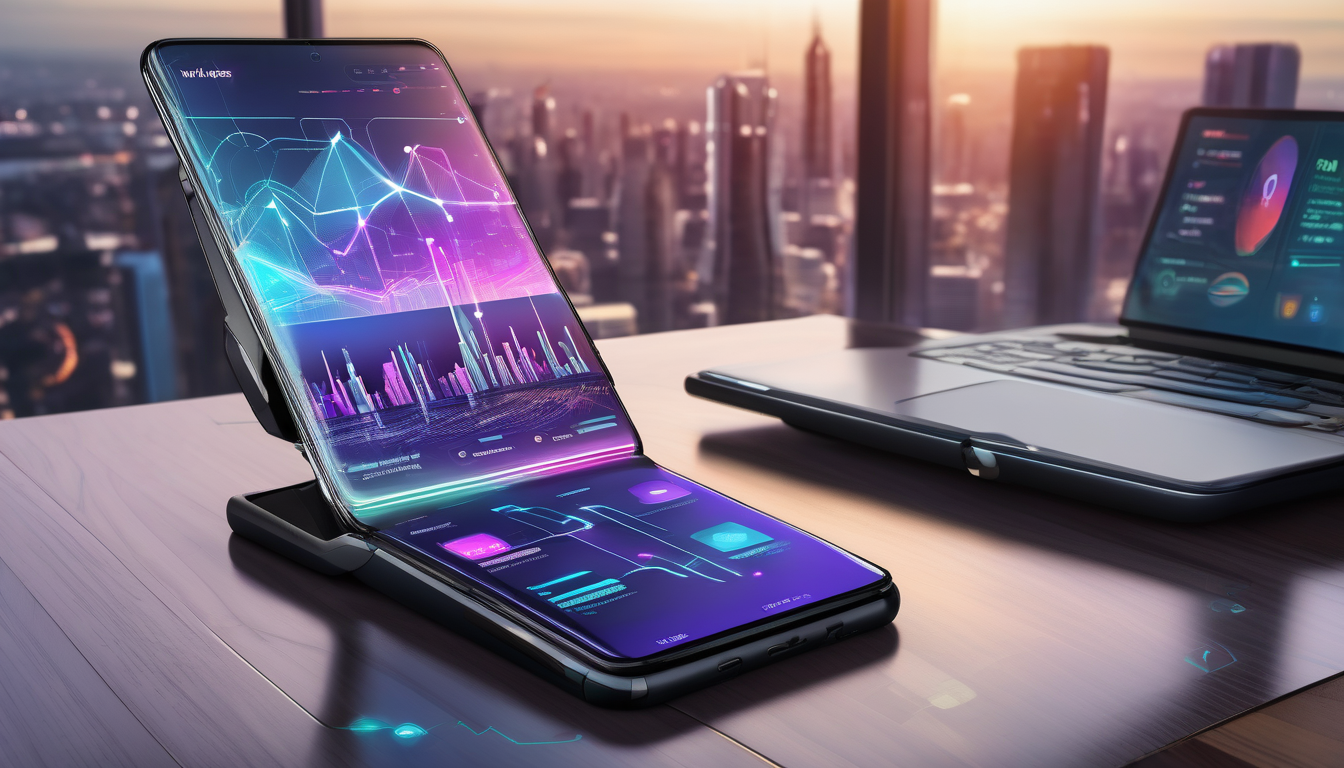The Future of Mobile App Development: What’s Next?

As we step into a new era of technology, the landscape of mobile app development is evolving at an unprecedented pace. The convergence of emerging technologies is not just a trend; it’s a revolution that promises to reshape how we interact with our devices. Imagine a world where apps are not only tools but also companions that understand our needs and preferences. This transformation is driven by advancements in user experience, the integration of artificial intelligence, and the rise of cross-platform solutions.
At the forefront of this evolution are augmented reality, blockchain, and the impending ubiquity of 5G technology. These technologies are not just buzzwords; they are the building blocks of a more immersive and secure mobile experience. For instance, augmented reality is redefining how we perceive the world around us, allowing apps to overlay digital information onto our physical surroundings. Blockchain is enhancing security and transparency, which is crucial in a time when data breaches are rampant. And with 5G, the speed and connectivity of mobile apps will reach new heights, enabling functionalities we once deemed impossible.
But what does this mean for developers and businesses? The answer lies in the ability to create apps that are not only functional but also intuitive and engaging. The integration of artificial intelligence is pivotal in this journey. AI is revolutionizing how apps interact with users, offering personalized experiences that adapt to individual preferences. Imagine an app that learns from your behavior and suggests content tailored just for you—this is the future we’re heading towards.
As we delve deeper into this exciting future, we’ll explore how AI-powered chatbots, natural language processing, and machine learning are enhancing user interactions and security. Additionally, we’ll examine the growing trend of cross-platform development, which allows developers to reach a broader audience with less effort. The focus on user experience will remain paramount, with minimalist designs and accessibility features becoming standard practice.
In summary, the future of mobile app development is bright and filled with potential. By embracing these innovations, developers can create applications that not only meet the needs of users today but also anticipate the demands of tomorrow. Are you ready to be part of this exciting journey?

Emerging Technologies in App Development
In the ever-evolving landscape of mobile app development, emerging technologies are paving the way for innovative solutions that not only enhance user experiences but also create new opportunities for developers and businesses. Technologies like augmented reality (AR), blockchain, and 5G are at the forefront of this transformation, revolutionizing how apps are built and how users interact with them.
Augmented reality is particularly exciting as it blends digital content with the real world, offering users immersive experiences that were previously unimaginable. Imagine using an app to visualize how a piece of furniture would look in your living room before making a purchase! This technology is not just a novelty; it has practical applications in various sectors, including retail, education, and healthcare.
On the other hand, blockchain technology is redefining security and transparency in app development. By utilizing decentralized networks, developers can create apps that ensure secure transactions and protect user data. This is especially crucial in industries like finance and healthcare, where data integrity is paramount. The ability to create tamper-proof records can build trust and enhance user confidence.
Then there’s the revolutionary impact of 5G technology. With its ability to provide faster data speeds and lower latency, 5G is a game-changer for mobile apps. Developers can now create applications that support high-definition streaming, real-time gaming, and seamless connectivity with IoT devices. The potential is limitless, and as 5G networks become more widespread, we can expect a surge in apps that leverage this technology to deliver richer experiences.
To summarize, the convergence of these emerging technologies is not just a trend; it’s the future of mobile app development. As developers embrace AR, blockchain, and 5G, we can anticipate a wave of innovative applications that not only meet user needs but also push the boundaries of what’s possible in the digital realm. The future is bright, and it’s exciting to think about where these technologies will take us next!

The Role of Artificial Intelligence
Artificial Intelligence (AI) is not just a buzzword anymore; it’s becoming the backbone of modern mobile applications. Imagine using an app that knows you better than your best friend! AI is making this a reality by enabling personalized experiences, predictive analytics, and smarter user interactions. This means that apps are becoming more intuitive, adapting to user preferences and behaviors in real-time.
One of the most exciting developments in AI for mobile apps is the rise of AI-Powered Chatbots. These chatbots are like having a personal assistant in your pocket, ready to provide real-time customer support. They enhance user engagement by answering questions quickly and accurately, making communication between businesses and their customers seamless. Just think about how frustrating it can be to wait on hold for customer service; chatbots eliminate that pain point!
Another fascinating aspect of AI is Natural Language Processing (NLP). This technology allows users to interact with apps using voice commands and conversational interfaces. Imagine asking your app to find a nearby restaurant or schedule an appointment just by speaking! NLP makes technology more accessible and user-friendly, breaking down barriers and allowing everyone to engage with apps effortlessly.
Let’s not forget about Machine Learning. This powerful AI subset analyzes user data to deliver personalized content and recommendations. For instance, have you ever noticed how streaming services suggest movies that you end up loving? That’s machine learning at work! By tailoring experiences to individual users, apps can significantly boost satisfaction and retention rates.
Security is another critical area where AI shines. With the increasing amount of sensitive data shared through mobile apps, ensuring user safety is paramount. AI plays a crucial role in enhancing app security by detecting anomalies and potential threats. It’s like having a digital watchdog that keeps an eye on your data, ensuring that you can enjoy your favorite apps without worrying about security breaches.
AI-Powered Chatbots
In today’s fast-paced digital world, are becoming a game changer for mobile applications. Imagine having a personal assistant available 24/7, ready to answer your queries and assist you with tasks at any hour. That’s the magic of chatbots! They are not just tools; they are revolutionizing the way businesses interact with their customers.
These intelligent bots leverage artificial intelligence to provide real-time customer support, enhancing user engagement and streamlining communication. When a user has a question or faces an issue, chatbots can respond instantly, reducing wait times and improving satisfaction. This immediate interaction is like having a friendly concierge at your fingertips, ready to assist you whenever needed.
Furthermore, chatbots can handle a variety of tasks, including:
- Answering frequently asked questions
- Guiding users through processes
- Collecting feedback and data
- Assisting with purchases and transactions
By integrating chatbots into mobile apps, businesses can significantly enhance user experience. They provide a personalized touch, making users feel valued and understood. For instance, when a user interacts with a chatbot, the AI learns from these interactions, allowing it to tailor responses and suggestions based on individual preferences. This level of personalization can lead to higher user retention and satisfaction.
Moreover, AI-powered chatbots are constantly evolving. They utilize natural language processing (NLP) to understand and respond to user inquiries more effectively. This means users can communicate in a more natural and conversational manner, making interactions smoother and more intuitive. Think of it as chatting with a friend rather than a machine!
In conclusion, integrating AI-powered chatbots into mobile applications is not just a trend; it’s a necessity for businesses looking to thrive in a competitive landscape. They offer a unique blend of efficiency, personalization, and accessibility, ensuring that users receive the support they need, exactly when they need it. As technology continues to advance, the potential for chatbots will only grow, making them an essential component of the mobile app experience.
Natural Language Processing
Natural Language Processing (NLP) is a game-changer in the world of mobile applications, bridging the gap between human communication and computer understanding. Imagine talking to your app as if you were chatting with a friend; that’s the magic of NLP! This technology allows apps to interpret, understand, and respond to human language in a way that feels natural and intuitive.
With NLP, users can give voice commands to their apps, making interactions seamless and efficient. Ever found yourself fumbling through menus just to perform a simple task? Well, with NLP, you can simply say, “Find me the nearest coffee shop,” and voilà! The app understands and delivers results in seconds. This not only enhances user experience but also makes technology accessible to a broader audience, including those who may struggle with traditional interfaces.
Moreover, NLP is not just about voice recognition; it also includes sentiment analysis, which helps apps gauge user emotions. For instance, if a user expresses frustration through a message, the app can respond with empathy or offer solutions, creating a more personalized experience. To illustrate the impact of NLP, consider the following:
| Feature | Benefit |
|---|---|
| Voice Commands | Hands-free operation, enhancing user convenience. |
| Sentiment Analysis | Personalized responses, improving user engagement. |
| Conversational Interfaces | Intuitive interactions, making technology more user-friendly. |
Incorporating NLP into mobile apps is not just a trend; it’s becoming essential for developers aiming to create applications that resonate with users. As we continue to embrace this technology, we can expect a future where our devices understand us better than ever before. So, next time you interact with an app, remember that behind the scenes, NLP is working tirelessly to make that experience as smooth and enjoyable as possible.
Machine Learning for Personalization
In a world where user expectations are sky-high, machine learning is stepping up as a game-changer in the realm of mobile app development. Imagine an app that not only understands your preferences but also anticipates your needs—sounds like magic, right? Well, it’s all thanks to sophisticated algorithms that analyze user behavior and data. These algorithms sift through mountains of information to deliver experiences that feel tailor-made for each individual.
Consider this: when you use your favorite shopping app, it doesn’t just show you random products. Instead, it curates recommendations based on your past purchases, browsing history, and even items that are trending among similar users. This personalized touch not only boosts user satisfaction but also significantly increases the chances of conversion. In fact, studies show that personalized experiences can lead to an increase in user retention rates by up to 30%!
Machine learning achieves this personalization through various techniques, including:
- Behavior Analysis: By tracking how users interact with the app, machine learning algorithms can identify patterns and preferences, allowing for smarter recommendations.
- Predictive Analytics: These algorithms predict future user behavior based on historical data, enabling apps to suggest products or features before the user even thinks of them.
- Dynamic Content Delivery: Machine learning enables apps to adjust content in real-time, ensuring users always see the most relevant information based on their current context.
Moreover, the beauty of machine learning is that it continually evolves. As users interact more with the app, the algorithms learn and adapt, refining their predictions and recommendations over time. This creates a feedback loop that enhances the user experience, making the app feel increasingly intuitive and engaging.
In summary, machine learning is not just a buzzword; it’s a vital component of modern mobile apps that strive for personalization. By leveraging this technology, developers can create apps that resonate deeply with users, fostering loyalty and driving engagement like never before. So, the next time you marvel at how an app seems to know you so well, remember: it’s not magic—it’s machine learning at work!
AI in App Security
In today’s digital landscape, where mobile apps are increasingly integral to our daily lives, security has become a paramount concern. With the rise of cyber threats, developers are turning to artificial intelligence (AI) to bolster app security measures. AI is not just a buzzword; it’s a powerful tool that enhances the way we protect sensitive user data and maintain trust in our applications.
One of the most significant advantages of integrating AI into app security is its ability to analyze vast amounts of data in real-time. This capability allows for the detection of unusual patterns and potential threats that a human might overlook. For instance, AI algorithms can identify malicious activities by monitoring user behavior and flagging anomalies. Imagine a security guard who never sleeps; that’s what AI offers—constant vigilance.
Moreover, AI can learn from past security breaches and adapt accordingly. By employing machine learning techniques, AI systems can improve their threat detection over time. This means that the more data they process, the better they become at predicting and preventing future attacks. In essence, it’s like having a personal bodyguard that gets smarter with each encounter.
To illustrate the effectiveness of AI in app security, consider the following key functions:
- Anomaly Detection: AI can spot deviations from normal behavior, allowing for swift action against potential breaches.
- Fraud Prevention: By analyzing transaction patterns, AI can help to identify fraudulent activities before they escalate.
- Automated Responses: In the event of a detected threat, AI can initiate automatic protocols to mitigate risks, such as locking accounts or alerting users.
As we move forward, the integration of AI in app security will not just be a luxury but a necessity. Developers must embrace these technologies to safeguard their applications and ensure user trust. With the stakes higher than ever, leveraging AI is not just about keeping data safe; it’s about creating a secure environment where users can interact without fear. The future of mobile app security lies in AI, and it’s time we harness its full potential.

Cross-Platform Development Solutions
In today’s fast-paced digital landscape, are becoming increasingly vital for businesses aiming to reach a broader audience without breaking the bank. With the rise of various mobile operating systems, developers are now tasked with creating applications that function seamlessly across multiple platforms, such as iOS and Android. This approach not only saves time but also maximizes resources, allowing companies to focus on what truly matters: delivering exceptional user experiences.
One of the most significant advantages of cross-platform development is its ability to streamline the development process. By utilizing a single codebase, developers can write code once and deploy it across different platforms. This efficiency translates to reduced development costs and faster time-to-market. Imagine launching your app simultaneously on both iOS and Android—this is the power of cross-platform solutions!
Popular frameworks like Flutter and React Native have emerged as leaders in this space, enabling developers to build high-performance applications that feel native to each platform. These frameworks offer a range of pre-built components and libraries, making it easier for developers to create stunning interfaces and smooth user experiences. For instance, Flutter’s hot reload feature allows developers to see changes in real-time, significantly speeding up the development process.
Moreover, the benefits of cross-platform development extend beyond just cost and time savings. Consider the following:
- Resource Efficiency: Companies can allocate their resources more effectively by using the same development team for multiple platforms, eliminating the need for separate teams for iOS and Android.
- Consistent User Experience: Cross-platform solutions ensure that users have a similar experience, regardless of the device they are using, which can lead to higher user satisfaction.
- Wider Reach: By launching on multiple platforms at once, businesses can tap into diverse markets, increasing their potential user base.
In conclusion, the shift towards is not just a trend; it’s a necessary evolution in the mobile app development landscape. As technology continues to advance, embracing these solutions will empower businesses to innovate, engage users effectively, and stay ahead of the competition.
Frameworks like Flutter and React Native
In the rapidly evolving world of mobile app development, Flutter and React Native have emerged as two leading frameworks that are transforming how developers create applications. These frameworks allow developers to write code once and deploy it across multiple platforms, significantly reducing the time and effort required for development. Imagine being able to build an app that works seamlessly on both iOS and Android without having to start from scratch for each platform—this is the magic of cross-platform development!
One of the standout features of Flutter is its rich set of pre-designed widgets that enable developers to create visually appealing and highly customizable user interfaces. This framework, developed by Google, provides a fast development cycle with its hot reload feature, allowing developers to see changes in real time without restarting the app. This not only speeds up the development process but also encourages experimentation and creativity.
On the other hand, React Native, developed by Facebook, brings the power of JavaScript to mobile app development. It allows developers to leverage their existing web development skills to create mobile applications. The framework’s component-based architecture makes it easy to reuse code across different parts of the app, which can lead to significant time savings. Furthermore, React Native has a vast community and a plethora of libraries, making it easier for developers to find solutions and enhance their apps.
Here’s a quick comparison of the two frameworks:
| Feature | Flutter | React Native |
|---|---|---|
| Language | Dart | JavaScript |
| Performance | High (native compilation) | Good (bridging to native components) |
| User Interface | Highly customizable widgets | Native components |
| Community Support | Growing | Large and well-established |
Both frameworks have their unique strengths and can cater to different project needs. Choosing between Flutter and React Native often depends on the specific requirements of the app, the team’s expertise, and the desired user experience. With the right framework, developers can create engaging, high-performance mobile applications that truly resonate with users.
Benefits of Cross-Platform Development
When it comes to mobile app development, cross-platform solutions are rapidly becoming the go-to choice for many developers and businesses alike. Why, you ask? Well, the benefits are numerous and compelling! First and foremost, cross-platform development allows for a single codebase that can be used across multiple platforms, such as iOS and Android. This not only reduces development time significantly but also cuts down on costs. Imagine the efficiency of writing your code just once and deploying it everywhere!
Moreover, this approach fosters resource efficiency. With cross-platform development, businesses can streamline their workflows by eliminating the need for separate teams for each operating system. This means that developers can focus their efforts on enhancing the app’s features rather than juggling multiple versions. In addition, it creates a more cohesive user experience. Users can enjoy a consistent interface and functionality whether they are on a smartphone, tablet, or desktop.
Another key advantage is the faster time to market. In today’s fast-paced digital world, getting your app out there quickly can make all the difference. Cross-platform development enables rapid iterations and updates, allowing businesses to respond swiftly to user feedback and market demands. This agility can be the difference between a successful app launch and a missed opportunity.
Furthermore, cross-platform frameworks like Flutter and React Native provide powerful tools that enhance performance and user experience. These frameworks come with robust libraries and components that help developers create visually appealing and high-performing applications. By leveraging these tools, developers can ensure that their apps not only look good but also function seamlessly.
In summary, the benefits of cross-platform development are hard to ignore. From cost savings and time efficiency to a more unified user experience, it offers a compelling case for developers looking to maximize their resources while delivering exceptional products. As the demand for mobile apps continues to grow, embracing cross-platform solutions might just be the key to staying ahead of the curve.

User Experience Trends
In the fast-paced world of mobile app development, user experience (UX) has emerged as a critical focal point. As developers strive to create apps that resonate with users, trends are evolving towards a more streamlined and engaging experience. One of the most significant trends is the shift towards minimalistic design. This approach emphasizes simplicity, allowing users to navigate apps with ease. By stripping away unnecessary elements, developers can highlight essential features, making the app more functional and user-friendly.
Furthermore, intuitive navigation is becoming a cornerstone of effective UX. Users today expect to find what they need quickly and effortlessly. This means that developers are prioritizing clear pathways and logical flows within apps. By implementing features such as gesture-based navigation or contextual menus, developers can enhance the overall experience, ensuring users don’t feel overwhelmed by too many options.
Another vital aspect of UX is accessibility. In an increasingly diverse world, catering to users with disabilities is not just a requirement; it’s a moral imperative. Developers are integrating accessibility features like screen readers, voice commands, and customizable interfaces. This inclusivity not only broadens the potential user base but also enriches the app’s value proposition. Ensuring that everyone can access and enjoy an app is a win-win for both developers and users.
To further illustrate these trends, consider the following table that summarizes key UX aspects:
| Trend | Description |
|---|---|
| Minimalistic Design | Focus on simplicity to enhance functionality and ease of use. |
| Intuitive Navigation | Clear pathways and logical flows to improve user satisfaction. |
| Accessibility | Features that ensure usability for all, including those with disabilities. |
In conclusion, as mobile app development continues to evolve, the emphasis on user experience will only grow stronger. By embracing trends like minimalistic design, intuitive navigation, and accessibility, developers can create apps that not only meet user expectations but exceed them. After all, in a world filled with options, the apps that prioritize user experience will stand out and thrive.
Importance of Minimalist Design
In today’s fast-paced digital world, minimalist design has emerged as a crucial element in mobile app development. Imagine walking into a room cluttered with furniture and decorations; it can be overwhelming, right? Now, picture a sleek, open space with only the essentials. That’s the essence of minimalist design in apps—it strips away the unnecessary to focus on what truly matters. This approach not only enhances the aesthetic appeal but also significantly improves the user experience.
Users are increasingly drawn to applications that offer a clean and intuitive interface. A minimalist design allows users to navigate effortlessly, reducing cognitive load and making interactions smoother. When users can find what they need without unnecessary distractions, they are more likely to engage with the app and return to it in the future. Here are a few key benefits of adopting a minimalist design:
- Enhanced Usability: By simplifying the design, users can quickly grasp how to use the app, leading to a more enjoyable experience.
- Faster Load Times: Minimalist designs often require fewer resources, which can lead to quicker loading times—an essential factor in retaining users.
- Focus on Content: With fewer elements to distract them, users can concentrate on the content and functionality, increasing engagement.
Moreover, minimalist design is not just about aesthetics; it also promotes accessibility. By keeping interfaces straightforward, developers can cater to a wider audience, including those with disabilities. Clear typography, ample white space, and well-defined buttons make it easier for all users to interact with the app.
In conclusion, the importance of minimalist design in mobile app development cannot be overstated. It creates a seamless user experience, enhances performance, and broadens accessibility. As developers strive to meet user expectations, embracing minimalist principles will undoubtedly pave the way for more successful and user-friendly applications.
Accessibility in Mobile Apps
In today’s digital age, accessibility in mobile apps is not just a feature; it’s a necessity. As developers, we have a responsibility to ensure that our applications are usable by everyone, including those with disabilities. Imagine navigating an app that doesn’t consider the needs of all users—it can be frustrating, right? This is where accessibility comes into play, transforming how we think about app design and functionality.
Creating accessible mobile apps means implementing features that cater to a diverse range of users. For instance, incorporating voice commands, adjustable text sizes, and color contrast options can significantly enhance the user experience for individuals with visual impairments. Additionally, providing alternative text for images and ensuring that all interactive elements are navigable via screen readers can make a world of difference.
Here are a few key aspects to consider when developing accessible mobile applications:
- Keyboard Navigation: Ensure that all functionalities can be accessed using keyboard shortcuts, making it easier for users who cannot use touchscreens.
- Voice Recognition: Implementing voice recognition allows users to interact with the app hands-free, providing a seamless experience for those with mobility challenges.
- Customizable UI: Allow users to modify the user interface, such as changing colors or layouts, to suit their preferences and needs.
By prioritizing accessibility, developers not only comply with legal standards but also open their apps to a larger audience. This inclusivity can lead to higher user satisfaction and retention rates. Think about it—when everyone can use your app, it’s not just good for business; it’s the right thing to do.
Moreover, accessibility can enhance the overall user experience for all users, not just those with disabilities. A well-designed app that is easy to navigate and understand can attract a wider audience, ultimately leading to increased engagement and success. So, as you embark on your next mobile app development project, remember that accessibility is key. It’s not just about reaching the finish line; it’s about making sure everyone can cross it together.

The Impact of 5G Technology
The rollout of 5G technology is not just a buzzword; it’s a game-changer for mobile app development. Imagine a world where apps load in the blink of an eye, where streaming your favorite show is as smooth as butter, and where gaming experiences are so immersive that you feel like you’re right in the action. That’s the promise of 5G! With its incredible speed and low latency, 5G is set to redefine what we can expect from mobile applications.
So, what exactly does this mean for developers and users alike? First off, 5G technology brings a significant increase in data transfer speeds. This means that applications can handle more data without lag, leading to richer and more engaging user experiences. For instance, augmented reality (AR) and virtual reality (VR) applications will thrive in a 5G world, allowing users to enjoy seamless interactions without frustrating delays.
Moreover, the enhanced connectivity of 5G allows for better integration with the Internet of Things (IoT). Imagine your smart fridge communicating with your grocery app, automatically updating your shopping list based on what you have at home. This level of connectivity is not just convenient; it opens up a whole new realm of possibilities for app developers looking to create innovative solutions.
With 5G, the possibilities for streaming services and mobile gaming are virtually limitless. Here are some key benefits:
- High-Quality Streaming: Users can enjoy 4K and even 8K video streaming without buffering interruptions.
- Low Latency: Gamers can experience real-time feedback, making competitive gaming more thrilling and fair.
- Increased User Engagement: The smooth performance of apps will keep users coming back for more.
As we look to the future, the impact of 5G on mobile app development is undeniable. Developers who embrace this technology will not only enhance user experiences but also position themselves at the forefront of innovation in the tech landscape. The question is, are you ready to ride the 5G wave?
Enhanced Streaming and Gaming Experiences
The advent of 5G technology is not just a buzzword; it’s a game-changer for mobile streaming and gaming. Imagine a world where your favorite shows stream in ultra-high definition without a hint of buffering. That’s the promise of 5G! With data speeds reaching up to 10 Gbps, users can enjoy seamless streaming experiences that were once thought impossible.
For gamers, this means the ability to play graphics-intensive games on mobile devices without lag. The low latency of 5G allows for real-time interactions, making multiplayer gaming more engaging and competitive. No more frustrating delays when you’re trying to make that perfect move in a fast-paced game. Instead, you can focus on strategy and teamwork, enhancing the overall gaming experience.
Furthermore, 5G opens the door to immersive technologies like augmented reality (AR) and virtual reality (VR). These technologies require significant bandwidth and low latency to deliver a smooth experience. With 5G, developers can create applications that provide users with interactive and lifelike experiences that were previously limited to high-end gaming consoles or PCs. Imagine walking through a virtual environment or battling foes in an augmented reality space right from your mobile device!
Here’s a quick look at how 5G enhances streaming and gaming:
- Faster Data Speeds: Users can download and stream content in seconds.
- Lower Latency: Real-time interactions in gaming reduce delays and improve responsiveness.
- Increased Capacity: More users can connect simultaneously without compromising performance.
- Enhanced Graphics: 5G supports higher-quality graphics for a more immersive experience.
In conclusion, the impact of 5G on mobile streaming and gaming is profound. It not only enhances the quality of content but also transforms how users engage with their favorite apps. As developers harness the power of 5G, we can expect a new era of mobile entertainment that will keep users glued to their screens!
IoT Integration with 5G
The advent of 5G technology is not just a game changer for mobile connectivity; it is a pivotal force driving the integration of the Internet of Things (IoT) into our daily lives. Imagine a world where your refrigerator can communicate with your grocery app, ordering milk automatically when you’re running low. This isn’t science fiction; it’s the future made possible by 5G.
With its lightning-fast data transfer speeds and minimal latency, 5G enables seamless communication between devices. This means that IoT devices can exchange data in real-time, enhancing their functionality and creating a more connected ecosystem. For instance, smart homes will become even smarter as various devices—from thermostats to security cameras—work together without any lag. The integration of 5G with IoT can lead to:
- Improved Efficiency: Devices can respond to commands almost instantaneously, which is crucial in applications like healthcare, where every second counts.
- Enhanced User Experience: Users will enjoy a more cohesive experience as their devices communicate more effectively, making everyday tasks simpler and more efficient.
- Scalability: Businesses can easily scale their IoT solutions, adding more devices without worrying about network congestion.
Moreover, the combination of 5G and IoT opens up new avenues for industries such as agriculture, where farmers can utilize smart sensors to monitor soil conditions and crop health in real-time. This data can lead to better decision-making, ultimately increasing yield and reducing waste.
As we look ahead, the integration of IoT with 5G will not only enhance individual user experiences but also revolutionize entire industries. The possibilities are boundless, promising a future where everything is interconnected, making our lives easier and more efficient than ever before. So, get ready for a wave of innovation that will transform the way we interact with technology!
Frequently Asked Questions
- What emerging technologies are influencing mobile app development?
Emerging technologies like augmented reality, blockchain, and 5G are significantly shaping the landscape of mobile app development. These technologies not only enhance user experiences but also open up new avenues for developers and businesses to explore.
- How is artificial intelligence changing the way we use mobile apps?
Artificial intelligence is making mobile apps smarter! With features like AI-powered chatbots for real-time customer support and machine learning for personalized recommendations, apps are becoming more intuitive and user-friendly, ultimately increasing user satisfaction.
- What are the advantages of cross-platform development?
Cross-platform development allows developers to create apps that work seamlessly on both iOS and Android. This approach not only reduces development time and costs but also streamlines workflows by eliminating the need for separate teams for each platform.
- Why is user experience (UX) so important in mobile app development?
User experience is crucial because it directly impacts user satisfaction and retention. Trends like minimalist design and enhanced accessibility features ensure that apps are not only functional but also easy to navigate, catering to a wider range of users.
- How will 5G technology affect mobile applications?
The rollout of 5G technology is set to revolutionize mobile apps by providing faster data speeds and lower latency. This means smoother streaming and gaming experiences, as well as better integration with IoT devices, enhancing overall functionality and user convenience.













